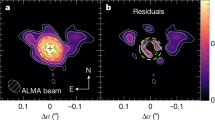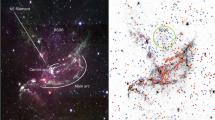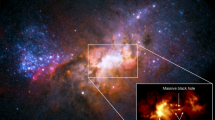Abstract
The central 0.1 parsecs of the Milky Way host a supermassive black hole identified with the position of the radio and infrared source Sagittarius A* (refs. 1,2), a cluster of young, massive stars (the S stars3) and various gaseous features4,5. Recently, two unusual objects have been found to be closely orbiting Sagittarius A*: the so-called G sources, G1 and G2. These objects are unresolved (having a size of the order of 100 astronomical units, except at periapse, where the tidal interaction with the black hole stretches them along the orbit) and they show both thermal dust emission and line emission from ionized gas6,7,8,9,10. G1 and G2 have generated attention because they appear to be tidally interacting with the supermassive Galactic black hole, possibly enhancing its accretion activity. No broad consensus has yet been reached concerning their nature: the G objects show the characteristics of gas and dust clouds but display the dynamical properties of stellar-mass objects. Here we report observations of four additional G objects, all lying within 0.04 parsecs of the black hole and forming a class that is probably unique to this environment. The widely varying orbits derived for the six G objects demonstrate that they were commonly but separately formed.
This is a preview of subscription content, access via your institution
Access options
Access Nature and 54 other Nature Portfolio journals
Get Nature+, our best-value online-access subscription
$29.99 / 30 days
cancel any time
Subscribe to this journal
Receive 51 print issues and online access
$199.00 per year
only $3.90 per issue
Buy this article
- Purchase on Springer Link
- Instant access to full article PDF
Prices may be subject to local taxes which are calculated during checkout



Similar content being viewed by others
Data availability
All data generated or analysed during this study are included in this published article.
Code availability
The orbit fit code is publicly available at https://zenodo.org/record/3305315#.XXmLPC3MzUY.
References
Schödel, R. et al. A star in a 15.2-year orbit around the supermassive black hole at the centre of the Milky Way. Nature 419, 694–696 (2002).
Ghez, A. M. et al. Stellar orbits around the Galactic center black hole. Astrophys. J. 620, 744–757 (2005).
Eckart, A. & Genzel, R. Stellar proper motions in the central 0.1 pc of the Galaxy. Mon. Not. R. Astron. Soc. 284, 576–598 (1997).
Morris, M. & Serabyn, E. The Galactic center environment. Annu. Rev. Astron. Astrophys. 34, 645–701 (1996).
Genzel, R., Eisenhauer, F. & Gillessen, S. The Galactic center massive black hole and nuclear star cluster. Rev. Mod. Phys. 82, 3121–3195 (2010).
Gillessen, S. et al. A gas cloud on its way towards the supermassive black hole at the Galactic Centre. Nature 481, 51–54 (2012).
Eckart, A. et al. Near-infrared proper motions and spectroscopy of infrared excess sources at the Galactic center. Astron. Astrophys. 551, A18 (2013).
Witzel, G. et al. Detection of Galactic center source G2 at 3.8 μm during periapse passage. Astrophys. J. 796, L8 (2014).
Witzel, G. et al. The post-periapsis evolution of Galactic center source G1: the second case of a resolved tidal interaction with a supermassive black hole. Astrophys. J. 847, 80 (2017).
Gillessen, S. et al. Detection of a drag force in G2’s orbit: measuring the density of the accretion flow onto Sgr A* at 1000 Schwarzschild radii. Astrophys. J. 871, 126 (2019).
Do, T. et al. Relativistic redshift of the star S0-2 orbiting the Galactic center supermassive black hole. Science 365, 6454 (2019).
Larkin, J. et al. OSIRIS: a diffraction limited integral field spectrograph for Keck. Proc. SPIE 6269, 62691A (2006).
Wizinowich, P. L. et al. The W. M. Keck Observatory laser guide star adaptive optics system: overview. Publ. Astron. Soc. Pacif. 118, 297–309 (2006).
Lockhart, K. E. et al. Characterizing and improving the data reduction pipeline for the Keck OSIRIS integral field spectrograph. Astron. J. 157, 75 (2019).
Campbell, R., Kjær, K. & Amico, P. 3D visualisation of integral field spectrometer data. ESO Messenger 148, 28–31 (2012).
Bautista, M. A. & Pradhan, A. K. Ionization structure and spectra of iron in gaseous nebulae. Astrophys. J. 492, 650–676 (1998).
Sitarski, B. N. Characterizing Infrared Excess Sources in the Galactic Center with Adaptive Optics. PhD thesis, Univ. California, Los Angeles (2016).
Peißker, F. et al. New bow-shock source with bipolar morphology in the vicinity of Sgr A*. Astron. Astrophys. 624, A97 (2019).
Phifer, K. et al. Keck observations of the Galactic center source G2: gas cloud or star? Astrophys. J. 773, L13 (2013).
Shahzamanian, B. et al. Polarized near-infrared light of the dusty S-cluster object (DSO/G2) at the Galactic center. Astron. Astrophys. 593, A131 (2016).
Paumard, T. et al. The two young star disks in the central parsec of the Galaxy: properties, dynamics, and formation. J. Phys. Conf. Ser. 54, 199–207 (2006).
Do, T. et al. Stellar populations in the central 0.5 pc of the Galaxy. I. A new method for constructing luminosity functions and surface-density profiles. Astrophys. J. 764, 154 (2013).
Lu, J. R. et al. Stellar populations in the central 0.5 pc of the Galaxy. II. The initial mass function. Astrophys. J. 764, 155 (2013).
Pfuhl, O. et al. The Galactic center cloud G2 and its gas streamer. Astrophys. J. 798, 111 (2015).
Prodan, S., Antonini, F. & Perets, H. B. Secular evolution of binaries near massive black holes: formation of compact binaries, merger/collision products and G2-like objects. Astrophys. J. 799, 118 (2015).
Murray-Clay, R. A. & Loeb, A. Disruption of a proto-planetary disc by the black hole at the Milky Way centre. Nat. Commun. 3, 1049 (2012).
Scoville, N. & Burkert, A. The Galactic center cloud G2: young low-mass star with a stellar wind. Astrophys. J. 768, 108 (2013).
Stephan, A. P. et al. Merging binaries in the Galactic center: the eccentric Kozai-Lidov mechanism with stellar evolution. Mon. Not. R. Astron. Soc. 460, 3494–3504 (2016).
Naoz, S. The eccentric Kozai-Lidov effect and its applications. Annu. Rev. Astron. Astrophys. 54, 441–489 (2016).
Stephan, A. P. et al. The fate of binaries in the Galactic center: the mundane and the exotic. Astrophys. J. 878, 58 (2019).
Raghavan, D. et al. A survey of stellar families: multiplicity of solar-type stars. Astrophys. J. Suppl. Ser. 190, 1–42 (2010).
Diolaiti, E. et al. Analysis of isoplanatic high resolution stellar fields by the StarFinder code. Astron. Astrophys. Suppl. Ser. 147, 335–346 (2000).
Boehle, A. et al. An improved distance and mass estimate for Sgr A* from a multistar orbit analysis. Astrophys. J. 830, 17 (2016).
Schödel, R., Najarro, F., Muzic, K. & Eckart, A. Peering through the veil: near-infrared photometry and extinction for the Galactic nuclear star cluster. Astron. Astrophys. 511, A18 (2010).
Lyke, J. et al. OSIRIS Toolbox: OH-Suppressing InfraRed Imaging Spectrograph pipeline. (Code Record ascl:1710.021, Astrophysics Source Code Library, 2017).
Yelda, S. et al. Improving Galactic center astrometry by reducing the effects of geometric distortion. Astrophys. J. 725, 331–352 (2010).
Yelda, S. et al. Properties of the remnant clockwise disk of young stars in the Galactic center. Astrophys. J. 783, 131 (2014).
Feroz, F. & Hobson, M. P. Multimodal nested sampling: an efficient and robust alternative to Markov Chain Monte Carlo methods for astronomical data analyses. Mon. Not. R. Astron. Soc. 384, 449–463 (2008).
Feroz, F., Hobson, M. P. & Bridges, M. MULTINEST: an efficient and robust Bayesian inference tool for cosmology and particle physics. Mon. Not. R. Astron. Soc. 398, 1601–1614 (2009).
Lucy, L. B. Mass estimates for visual binaries with incomplete orbits. Astron. Astrophys. 563, A126 (2014).
Kosmo O’Neil, K. et al. Improving orbit estimates for incomplete orbits with a new approach to priors — with applications from black holes to planets. Astron. J. 158, 1 (2019).
Neyman, J. Outline of a theory of statistical estimation based on the classical theory of probability. Phil. Trans. R. Soc. Lond. A 236, 333–380 (1937).
Schartmann, M. et al. 3D adaptive mesh refinement simulations of the gas cloud G2 born within the disks of young stars in the Galactic center. Astrophys. J. 811, 155 (2015).
Yusef-Zadeh, F., Morris, M. & Ekers, R. D. New structures near the compact radio source at the Galactic centre. Nature 348, 45–47 (1990).
Lo, K. Y. & Claussen, M. J. High-resolution observations of ionized gas in central 3 parsecs of the Galaxy — possible evidence for infall. Nature 306, 647–651 (1983).
Becklin, E. E., Gatley, I. & Werner, M. W. Far-infrared observations of Sagittarius A – the luminosity and dust density in the central parsec of the Galaxy. Astrophys. J. 258, 135–142 (1982).
Russell, S. S. et al. in Meteorites and the Early Solar System II (eds Lauretta, D. S. & McSween, H. Y. Jr) 233–251 (Univ. Arizona Press, 2006).
Jalali, B. et al. Star formation in the vicinity of nuclear black holes: young stellar objects close to Sgr A*. Mon. Not. R. Astron. Soc. 444, 1205–1220 (2014).
Yusef-Zadeh, F. et al. Sgr A* and its environment: low-mass star formation, the origin of X-ray gas and collimated outflow. Astrophys. J. 819, 60 (2016).
Tylenda, R., Soker, N. & Szczerba, R. On the progenitor of V838 Monocerotis. Astron. Astrophys. 441, 1099–1109 (2005).
Tylenda, R. & Kamiński, T. Evolution of the stellar-merger red nova V1309 Scorpii: spectral energy distribution analysis. Astron. Astrophys. 592, A134 (2016).
MacLeod, M. et al. Lessons from the onset of a common envelope episode: the remarkable M31 2015 luminous red nova outburst. Astrophys. J. 835, 282 (2017).
Genzel, R. et al. The stellar cusp around the supermassive black hole in the Galactic center. Astrophys. J. 594, 812–832 (2003).
Naoz, S. & Fabrycky, D. C. Mergers and obliquities in stellar triples. Astrophys. J. 793, 137 (2014).
Antonini, F., Faber, J., Gualandris, A. & Merritt, D. Tidal breakup of binary stars at the Galactic center and its consequences. Astrophys. J. 713, 90–104 (2010).
Do, T. et al. Envisioning the next decade of Galactic Center science: a laboratory for the study of the physics and astrophysics of supermassive black holes. Preprint at https://arXiv.org/abs/1903.05293 (2019).
Naoz, S. et al. Confusing binaries: the role of stellar binaries in biasing disk properties in the Galactic center. Astrophys. J. 853, L24 (2018).
Acknowledgements
We thank G. Witzel, R. Schödel and E. Becklin for providing insight and expertise. Support for this work was provided by NSF AAG grant AST-1412615, Jim and Lori Keir, the W. M. Keck Observatory Keck Visiting Scholar programme, the Gordon and Betty Moore Foundation, the Heising-Simons Foundation, and Howard and Astrid Preston. A.M.G. acknowledges support from her Lauren B. Leichtman and Arthur E. Levine Endowed Astronomy Chair. The W. M. Keck Observatory is operated as a scientific partnership among the California Institute of Technology, the University of California, and the National Aeronautics and Space Administration. The Observatory was made possible by the generous financial support of the W. M. Keck Foundation. The authors wish to recognize and acknowledge the very significant cultural role and reverence that the summit of Maunakea has always had within the indigenous Hawaiian community. We are most fortunate to have the opportunity to conduct observations from this mountain.
Author information
Authors and Affiliations
Contributions
A.C., R.D.C. and M.R.M. designed the project, and carried out the analysis and the interpretation of the results. A.M.G. supervised the observing, data acquisition and data reduction. T.D. and D.S.C. obtained and reduced the data. A.H., K.K.O’N. and B.N.S. contributed to the analysis and to the manuscript. A.C. wrote the manuscript with support from M.R.M. and R.N.C., and with contributions from all other authors. All authors provided critical feedback and helped gather data.
Corresponding author
Ethics declarations
Competing interests
The authors declare no competing interests.
Additional information
Publisher’s note Springer Nature remains neutral with regard to jurisdictional claims in published maps and institutional affiliations.
Extended data figures and tables
Extended Data Fig. 1 Infrared-excess sources and G objects.
Shown are the proper motions of the G sources (from 2006, in blue, to 2018, in yellow) along with the positions of infrared-excess sources7 in orange (data obtained with NACO at the VLT in 2005) and17 in magenta (data obtained with NIRC2 at Keck in 2005). The red trace shows the proper motion of S0-2 (from NIRC2) as reference. The average OSIRIS field is displayed as a dotted rectangle.
Extended Data Fig. 2 New G objects in the L band.
We show the deconvolved L′ images from NIRC2 for several epochs (each year is reported in the top-left corner). The green circles indicate the position of the G objects in the Kn3 OSIRIS band and of Sgr A*.
Extended Data Fig. 3 Spectra of the new G objects showing the Brγ emission line over time.
Top row, G3 (left) and G4 (right); bottom row, G5 (left) and G6 (right). The spectra are extracted epoch by epoch (black). The Gaussian fit of the Brγ emission line (red) is superimposed. There is no significantly detected variation (all values are compatible within 1σ) in the linewidth for any of the objects. The data quality varies and the emission of the objects blends with neighbouring features as it changes radial velocity (RV) and position: this gives sometimes the impression of a broadening of the line which is not real. The emission line at the rest velocity is part of the extended emission present across the field and does not change with time.
Extended Data Fig. 4 Spectra of the G objects showing Brγ and [Fe iii] emission lines.
The Kn3 spectra of G objects G6–G1 are extracted over an aperture of 1.5-pixel radius from the 2006 combined dataset. The dotted lines show the rest-frame velocity of the Brγ and [Fe iii] emission lines. G3, G4, G5 and G6 show both Brγ and [Fe iii] emission moving at the same velocity (Doppler-shifted emission indicated by the arrows), whereas G1 and G2 show only Brγ emission.
Extended Data Fig. 5 Corner plots for orbit fitting of G3, G4, G5 and G6.
See Methods section ‘Orbit fitting’ for details of the parameters displayed.
Extended Data Fig. 6 Unit conversion factors as a function of time.
a, Factor obtained using calibration A stars (single frames in grey triangles, median for each epoch in red dots, dispersion used as error bar). b, Factor obtained using stars in the science field. The dispersion when using stars in the science field is much larger. We use the A stars, for which most of the variation corresponds to hardware changes in the instrument. We use the median value for each instrument period (green solid line) and use the dispersion as an estimate of the uncertainty (green dashed lines). See Methods section ‘Flux calibration’ for details.
Rights and permissions
About this article
Cite this article
Ciurlo, A., Campbell, R.D., Morris, M.R. et al. A population of dust-enshrouded objects orbiting the Galactic black hole. Nature 577, 337–340 (2020). https://doi.org/10.1038/s41586-019-1883-y
Received:
Accepted:
Published:
Issue Date:
DOI: https://doi.org/10.1038/s41586-019-1883-y
Comments
By submitting a comment you agree to abide by our Terms and Community Guidelines. If you find something abusive or that does not comply with our terms or guidelines please flag it as inappropriate.



